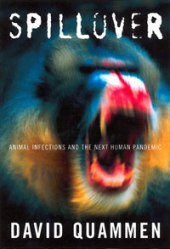
Lynn Donaldson
David Quammen is probably best known for his writings about bizarre, beastly, or wildly eccentric animals, and the scientists who study them. His long-running column for Outside magazine, Natural Acts, read like a bestiary of the planet’s most intriguing creatures. And with books like his 1997 tome The Song of the Dodo and the 2004 Monster of God, he has sounded the alarm about the looming extinction crisis and the unraveling of the Earth’s ecosystems. Now he’s written another opus, this one about creatures so small that we can see them only with the aid of an electron microscope. It’s his most captivating — and, by far, his scariest — book yet.
Quammen says the inspiration for Spillover: Animal Infections and the Next Human Pandemic came while he was on a trans-African hike with biologist Michael Fay in 2000. Sitting around a campfire one night, some of their guides told stories about Ebola sweeping through their village. “It was hideous. It was scary. It was confusing. They didn’t know what it was,” Quammen says. “They didn’t know that it was a virus — they just knew that their friends and loved ones were dying.”
Then one of the men mentioned a peculiar thing. Around the time of the Ebola outbreak, he’d seen a pile of 13 dead gorillas in the forest nearby. That, says Quammen, was a moment. What Quammen knew, but his guides apparently did not, is that Ebola infects gorillas and chimpanzees as well as humans. The virus lived quietly in a “reservoir” host — an animal that carries the virus but is not sickened by it — until one day, it “spilled over,” crossing the species divide and wreaking havoc on humans and apes alike. That jump from one species to another is called zoonosis, and over the course of researching this book, Quammen would discover that it is a unsettlingly common occurrence.
If it sounds like the makings of a horror story, well, it is, but Quammen doesn’t do horror. He’s too brainy and flat-out curious for that. As with much of his previous work, this tale is told as a slowly unfolding mystery, in which we follow a far-flung constellation of scientists as they piece together a complex puzzle involving their subjects — in this case, viruses, and the wild animals that carry them. This quest has Quammen chasing all over the planet with researchers who investigate the mysterious deaths of Australian racehorses, catch chimpanzee piss as it rains from the treetops, and accomplish other outlandish feats.
The result is a page-turner that includes, among other things, the jaw-dropping tale of how the AIDS virus jumped from a chimpanzee to a human in the southeastern corner of Cameroon around 1908 and spread across the globe.
Quammen, a contributing writer at National Geographic, stopped by the Grist offices last week during a nationwide book tour.
Q. I came away from this book somewhat amazed that we are not sicker.
A. Well, we’ve lost 30 million people to HIV in the last 30 years. And we lose a lot of people each year to influenza and to some of these other things. That makes us pretty sick. And we could be much sicker. We’re really moving into the next phase of exposing ourselves to these zoonotic diseases because we’re pressing more and more into the forests where all the biological diversity lives, and the more biological diversity you have the more viruses you have.
Q. We often hear that tropical forests, these last wild places, are reservoirs for medicines, and sources of all these riches. This book turns that on its head and says, actually, they’re also potentially really dangerous.
A. They’re booby-trapped in a way. Because where you have high diversity of animal species and plant species, you also have high viral diversity. Virtually every species that you can investigate, you’re gonna find at least one unique form of virus. Every rat, every mouse, every butterfly, every lizard, you’re gonna find a unique virus. And if you go ripping in there and gobbling up all these things, you’re gonna gobble up some viruses. And many of them may be harmless in humans. Some of them won’t be.
Q. Was the book, on some level, another call to protect those last wild places?
A. Well, yes. It’s a roundabout way of reminding people that, look, we don’t own this planet, we’re not here alone, we’re connected to all these other species. And disruption is natural, but certain kinds of disruption are more unnatural than others. And the kind that we’re causing has consequences. And disease is one of the consequences.
Q. We’re pressing deeper into these last wild places, but at the same time, we’re becoming a more urban species. That has some consequences, too.
A. The more we live in high-density situations, the more open landscape is left. And there’s good sense in that. But high-density aggregations of any host species predispose that host species to rampages of infectious disease. So as we increase our density, as our big cities go from being cities of 8 million to cities of 15 million and 20 million people, we’re piling up a lot of fuel together in a place where — I’m changing metaphors now — the spark of an infectious microbe can make a bigger conflagration.
And we’re moving around more quickly. I don’t think I use the terms in the book, but as I’ve been talking about this I find myself talking more and more about the yin and yang of disruption and connectivity. The disruption is what exposes us to the viruses and the connectivity is what gives the viruses a better opportunity to burn through more individuals, to create more mayhem, to kill more people.
Q. Talk to me a little about our abilities to fight off these diseases.
A. Most of these diseases that emerge from animals are viruses. And the nastiest of them and the most difficult of them are viruses. And the ones that evolve and adapt to new hosts most quickly are viruses. Antibiotics don’t work on viruses. Trying to treat a virus with an antibiotic is like trying to clean the dirt off your driveway using a flashlight instead of a garden hose. Doesn’t work. There are some antiviral drugs. We know about antiviral cocktails that are controlling the replication of HIV. They don’t kill it off, they just slow it down.
Q. What are the chances that we’ll be able to wipe out some of these diseases, the way we did with smallpox, for example?
A. I talk a little bit in the book about the dream of eradication. Humans like to have final, complete solutions. We had that problem, now it’s fixed, it’s gone. We eradicated smallpox. We might eradicate polio. Why? Because they’re not zoonotic. They have nowhere to hide except in humans. If we cure, vaccinate, protect every human, then those viruses have nowhere else to go. Maybe they go into a test tube in a freezer somewhere in the CDC. But they’re not in the wild anymore.
With zoonotic viruses, it’s much, much more difficult, and that’s where we have to realize the imperfection of our solutions and the finitude of human power, even medical science. We shouldn’t expect to eradicate a lot of these things. We need to find ways to live with them, just the way we have gone a long way in finding ways to live with HIV. At least in this country, at least in places where people can afford drug cocktails, people are living a long time. Magic Johnson is still smiling. He was really lucky that he was that much younger than Rock Hudson. He came along late enough that when he got sick they were starting to have a handle on how to control it.
Q. I don’t think of Rock Hudson and Magic Johnson as people in your pantheon.
A. Well, they’re part of the story. And I realize I’m dating myself. How many of your readers know who Rock Hudson is — was? You can Google Rock Hudson, people.
Q. In the last section of the book, you arrive at the unavoidable question: Are we ourselves an outbreak, like a disease?
A. As I say in the book, outbreaks are an ecological phenomenon. They’re not unnatural in that sense. Certain kinds of species have a propensity for these huge rises followed by these crashes. And so what I call The Analogy essentially is a question that I have put to some of the experts, including the people who study outbreaks in tent caterpillars and forest Lepidoptera: Is it reasonable to think of us humans as an outbreak population? And generally they say yes.
There has never been any large-bodied vertebrate before us on this planet that was anywhere near as abundant. There have never been 7 billion apes of any species. There have never been 7 billion water buffalo or deer of any species. There has never been anything like what we are now. And in that sense we’re an outbreak population … and the thing about outbreaks is, they end.
Q. Folks who study these diseases talk about “the next Big One” — the next devastating epidemic — the same way geologists talk about the next monster earthquake.
A. Yeah, the experts I’ve talked to generally agree that yes, it is very likely that there will be a next Big One. And if there is, they say with an even higher degree of confidence, then it’ll be a zoonotic bug — something that comes out of an animal. It’ll be a virus, and it’ll most likely be a single-stranded RNA virus, because those are the ones that are most protean, most plastic, most adaptable. So that tells them to watch for new RNA viruses emerging from animals. And they are watching, very carefully.
Q. Who are these people?
A. I’ve found myself amid a whole new guild of field biologists. And these people are trained with this interesting combination of skills — archetypically, it’s somebody who has a degree in veterinary medicine, a PhD in ecology, and a masters in public health. That’s the person who’s on the front lines of this. Those are the people that I follow around in this book for five years, going to interesting places with them — where they’re in a jungle in central Africa and they want to tranquillize dart gorillas to take blood samples to check for Ebola antibodies, or they’re trapping bats on a rooftop in Bangladesh to look for Nipah virus, or climbing around in limestone caves in southern China looking for the SARS virus.
I hope very much that this is not a gloomy book, that this is a page-turner, that this has got a lot of pleasure and thrill in it. And if so, then a lot of that comes from me having the opportunity to tell the stories of these amazing people.
Q. But a lot of our ability to slow down or cope with these diseases rests on changing human behavior. Our response to climate change doesn’t leave me optimistic about changing human behavior.
A. I share your pessimism and frustration about our lack of ability, lack of will, to do anything about climate change. But I think that this is a little bit different. We’re being told, you should drive less because if you don’t, people in Tahiti will be underwater, or the polar bear will go extinct, or people in Wisconsin will start to get malaria. With [infectious diseases], we’re saying to people, you should do this, or you’re gonna die next week. That’s a little bit easier case to sell.




